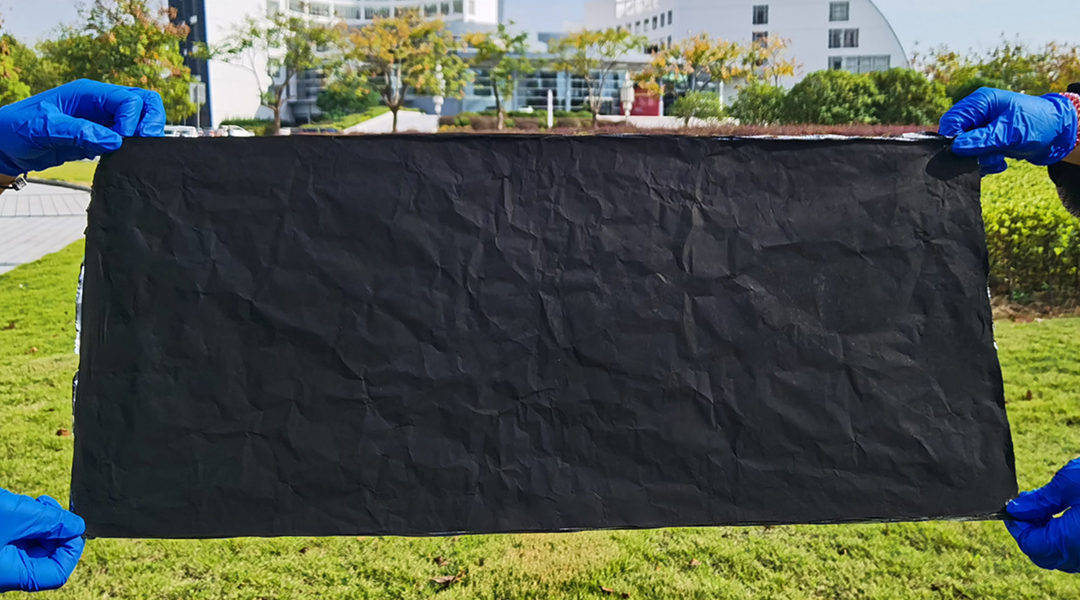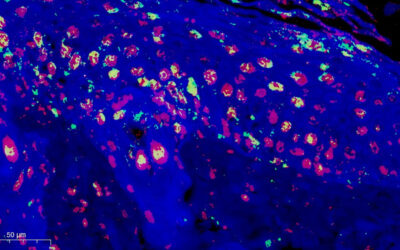The skin is the largest organ of the human body with a myriad of functions. Electronic skins (E-skins) are highly flexible and adaptable polymer-based electronics designed to mimic the functions of the multilayered human skin.
E-Skins that are able to sense touch can help transplantation patients to adapt more easily by responding adequately to defined stimuli. Interestingly, E-Skins can further be applied in robotics and are used, for example, to extend the autonomous intelligence of the devices.
A joint research team from Donghua University and Shanghai Institute of Ceramics Chinese Academy of Sciences (SICCAS) led by Professors Liming Wang and Yin Cheng set out to recreate the multi-layered architecture and the function of the human skin by designing the SPRABE-skin. The novelty of this E-Skin comes from the fact that it is made up of several distinct layers which are created successively via a process that guarantees scalability and reproducibility to ensure durability and function of the used materials.
The SPRABE skin allows the acquisition of different bio signals such as electrocardiograph (ECG), electromyograph (EMG), electroencephalograph (EEG).
The researchers envision a SPRABE-skin based human healthcare system for long-duration and dynamic monitoring of physical processes during workouts and other activities. Their results have recently been published in Advanced Functional Materials.
Cheng took the time to introduce us to the exciting world of E-skins.
What are electronic skins or E-skins? Where are they finding application?
Electronic skin (E-skin) is a kind of artificial skin with mechanical flexibility and external stimuli perception. The combination of high adaptability to unstructured surfaces and multi-signal acquisition ability makes it very suitable for tele-medicine and intelligent robotics. For example, when electronic skin is deployed to robots, mechano-sensing can extend their autonomous intelligence by improving manipulation sensitivity and safety in highly human-interactive tasks (such as caring for the elderly).
Another example, with the E-skin attached on human body, various health-related signals can be collected without affecting the body motions, so as to carry out personalized health monitoring for active and early diagnosis.
Can you tell us about your own E-skin, SPRABE-skin (scalable fabrication strategy for a bioinspired E-skin)? What inspired its creation?
Spraying and electrostatic spinning are both scalable high-throughput, large-area manufacturing techniques. The uniformity, thickness and flexibility of the coating can be easily adjusted through droplet size, spraying distance and spraying time. It is a large-scale preparation method commonly used in the production of various industrial fields such as automobile, aviation, national defense and energy. Inspired by the multi-layered architecture of human skin for multi-functions, we designed the SPRABE-skin with protective layer (P-layer), strain sensing layer (S-layer), isolation layer (I-layer) and electrode layer (E-layer).
The protective layer helps to resist external influences, the strain sensing layer and the electrode layer collect strain and biopotential signals respectively, and the isolation layer avoids signal crosstalk between biomechanical and bioelectric sensing.
What materials do you use to make SPRABE-skin mimic the real thing?
SPRABE-skin is assembled by using electrospun TPU nanofibrous film with low modulus like skin, conductive materials such as carbon nanotubes and MXene, and water-based polyurethane as bonding materials to mimic human skin structure. The conductive carbon nanotubes and MXene are arranged on the TPU electrospun fiber film as the sensing layer, which simulates the nerve fibers in human skin.
When the external force is exerted and the strain is generated, the external mechanical stimulus is fed back through the change of resistance. MXene and WPU are used as electrode layers, which provide good conductivity and adhesion at the same time, to allow the transmission of bioelectrical signals.
How does it differ from other forms of this type of technology?
The commonly used fabrication methods of stretchable strain sensors include: construction of conductive permeability network through chemical vapor deposition or sputtering deposition, molding of thermoplastic film polymer and conductive coating, blending of conductive ink and polymer precursor (hydrogel, silicone rubber, etc.), micromachining of pattern interface microstructure, etc. Compared with these methods, our method of combining electrospinning and spraying to fabricate skin-bonded electronic skin layer by layer has advantages in terms of scalability, repeatability and controllability of material properties.
How do you make SPRABE-skin? Can you tell us about your scalable fabrication strategy?
Firstly, MXene/CNTs were sprayed on the surface of the electrospun TPU nanofibrous film as the sensing layer, and then TPU layers were electrospun as the isolation layer and the protective layer on both sides respectively. Finally, MXene/WPU was sprayed on the surface of the isolation layer as the electrode layer. The preparation method mainly involves electrostatic spinning and spraying process, which are commonly used in industrial production to achieve large-scale production.
How affordable are they?
Electrospinning and spraying techniques are mature in industry, and no special instruments are needed. For the materials used in our E-skin, waterborne polyurethane and carbon nanotubes have mature industrial production methods and processes, which are quite cheap. The MXene cost more on the market, but the usage amount is very small, and the cost can be considerably reduced by synthesis in our own lab.
Why is scalability/mass production important to include in your strategy?
With the diversification of electronic skin functions, the application fields are more and more extensive, including but not limited to robotics, medical diagnosis, and prosthesis. The large-scale use of electronic skin in practical applications puts forward higher requirements for large-scale production. At present, it is difficult for most multi-functional electronic skins to be produced on a large-scale due to expensive materials, complex preparation process and special processing equipment, which is a problem in the development and application of electronic skin.
How often can a SPRABE-skin be reused and is its disposal eco-friendly? Is this something that’s important to consider? Why?
Effective operating duration, reuse cycles and environmental protection are very important for e-skin. SPRABE-skin has so far been tested to ensure that it remains attached to the skin surface for at least 48 hours without detachment and maintaining a stable signal. In addition, SPRABE-skin can still ensure sufficient adhesion force to achieve good sensing performance after 16 attach-detach cycles. After service time, the SPRABE-skin can be soaked in ethanol to dissolve WPU, and collect the CNTs and MXene by centrifugation for recycling.
In your recent study, you demonstrated SPRABE-skin’s ability to collect data for an electrocardiogram (ECG). How does it differ from a conventional ECG?
Traditional ECG acquisition is mostly achieved by Ag/AgCl gel electrodes, which can collect stable signals under static conditions, but suffer severe signal distortion or even signal loss under dynamic conditions (e.g., body motions and underwater condition). SPRABE-skin can realize stable collection of ECG signals in dynamic, underwater, or even water impact conditions, suppressing the signal distortion by providing a robust skin-electrode interface.
Where else could the SPRABE-skin be used in a clinical or at-home setting?
As the SPRABE-skin is capable of real-time body motion and electrophysiological signals, it could be integrated into a wearable all-day wireless monitoring system for the elderly and disabled groups. Such SPRABE-skin based applications could provide constant feedback relatingto human motion and ECG signals, to report accidental events.
Do you envision a future version of SPRABE-skin that could perhaps act as an artificial skin, helping people affected by burns or similar accidents?
Currently, our SPRABE-skin based wearable systems is designed to capture biomechanical and bioelectrical signals and transmitted to smart phones for further analysis. To act as an artificial skin, we need to further integrate a stimulating system that transforms the touch signals on SPRABE-skin to vibration or electrical stimulation on human body as easily perceptible feedbacks. This brings new challenges in system integration and miniaturization, and also signal modulation.
Are there any other future research directions you’re planning to take this?
For electronic skin, the function has multiple dimensions, not only limited to mechanical sensing and electrophysiological signals, but also include visual and olfactory sensing. In addition, the self-healing and Eco-friendly recyclability of E-skins are also our research focus in the future.
Reference: Liming Wang, Yin Cheng, et al., A Stretchable, Breathable, And Self-Adhesive Electronic Skin with Multimodal Sensing Capabilities for Human-Centered Healthcare, Advanced Functional Materials (2023). DOI: 10.1002/adfm.202303881

















